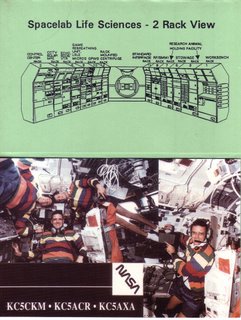Tuesday, January 24, 2006
ETA Thirteen Years Three Months

In October 1993, I made my first voice contact with an Astronauts on-board the STS-58 Columbia Space Shuttle. Amateur radio was relatively new to me and it was a great thrill to talk with Mission Specialist William S. McArthur.
This was the 15th flight for the Shuttle Columbia carried a life science space laboratory in the cargo bay. I'm sure at the time astronauts were looking forward to doing experiments aboard an orbiting space station. A secondary payload, the Shuttle Amateur Radio EXperiment (SAREX), was flown to encourage public participation in the space program. Using an on-board Amateur Radio station, the astronauts communicated with hundreds of hams, students and their parents and teachers. I was one of the lucky ones.
Thirteen years three months later on January 24,2006, as I was tuning through some programmed frequency’s on my on my Yaesu FT-847 Radio, I heard NA1SS the club call aboard the International Space Station. He was calling CQ Honduras as they past over the Yucatan Peninsula. He was 5/9 so I gave my call KR4ST Florida. He came back to my call and I told him this was my second voice contact with an Astronaut, my first was STS-58. To my surprise it was Bill McArthur and he agreed he was the astronaut I made contact so many years ago . God speed Bill from KR4ST Fort Myers Florida.
Monday, January 02, 2006
Why Amateur Radio Operators are called HAM's
Have you ever wondered why we radio amateurs are called "HAMS"? Well, according to the Northern Ohio Radio Society, it goes like this: the word ham was applied in 1908 and was the call letters of one of the first Amateur wireless stations operated by some members of the HARVARD RADIO CLUB. There were Albert S. Hyman, Bob Almy and Peggie Murray. At first, they called their station Hyman-Almy-Murry. Tapping out such a long name in code soon called for a revision and they changed it to HY-AL-MU, using the first two letters of each name. Early in 1909, some confusion resulted between signals from Amateur wireless HYALMU and a Mexican ship named HYALMO, so they decided to use only the first letter of each name and the call became HAM. In the dearly pioneer unregulated days of radio, Amateur operators picked their own frequency and call letters. Then, as now, some Amateurs had better signals than some commercial stations. The resulting interference finally came to the attention of congressional committees in Washington and they gave much time to proposed legislation designed to critically limit Amateur activity. In 1911, Albert Hyman chose the controversial Wireless Regulation Bill as the topic for his thesis at Harvard. His instructor insisted that a copy be sent to Senator David I. Walsh, a member of one of the committees hearing the bill. The Senator was so impressed, he sent for Hyman to appear before the committee. He was put on the stand and described how the little Amateur station was built. He almost cried when he told the crowded committee room that if the bill went through, they would have to close up the station because they could not afford the license fees and all the other requirements that were set up in the bill. The debate started and the little station HAM became a symbol of all the little Amateur stations in the country crying out to be saved from menace and greed of the big commercial stations who did not want them around. Finally, the bill got to the floor of Congress and every speaker talked about the poor little station "HAM". That's how it all started. You will find the whole story in the Congressional Record. Nationwide publicity associated station HAM with Amateurs from that day to this, and probably to the end time, in radio, and Amateur is a HAM.
